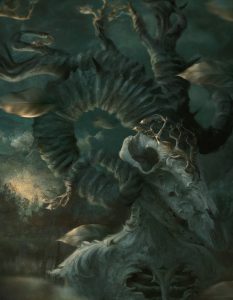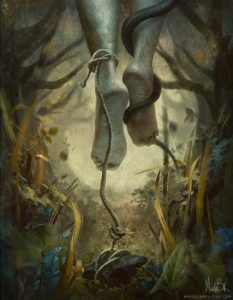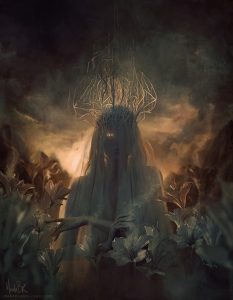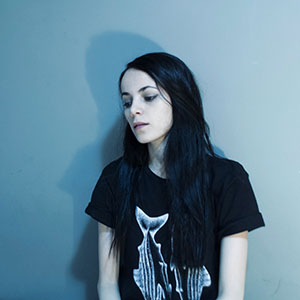
This month’s Apex Magazine cover artist is Marcela Bolívar, and she’s provided us with an astonishing piece called, “Ipocondrie.” Bolívar likes to stage imaginary situations through mythological figures and constructed personal symbols. In her work, artificial objects and a detailed representation of flora intertwine human bodies and objects with fantastical representations which are made out of photos, paintings, and sculptures serving as metaphors of a human life that wanders between daydreams and reality.
APEX MAGAZINE: Many of your pieces feature intricate textures, such as “Gold Tiberius,” that mix throughout to both delineate or even relax areas of the image. How do those textures help define the story of the characters in those images, or their environment?
MARCELA BOLÍVAR: Textures are very important to me. They help me define the mood of an image and to enhance the elements I want to draw attention to.
In “Gold Tiberius” I wanted to represent Pan as forgotten god, a creature between life and death and still an inhabitant of the wilderness. Those intricate textures are then marks and trails of a long gone past of decadence and exuberance placed on a now decayed body that carries them with pride.
Other elements such as skies and backgrounds take a new life when I add my painted textures, and help to enrich the tones with subtle shadows and highlights. It is my way of adding something almost palpable and real amidst a heavily manipulated assemblage.
AM: One thing you mention in some of your tutorials is the difficulty of explaining how you create your work. As an artist myself, I also find it difficult at times, trying to avoid an answer such as, “that’s just how I hold the pencil.” How do you approach explaining the mystery of that creation? Is it based on explaining the literal techniques you use, or trying to explain the nature of your ideas?
MB: It is indeed very difficult to explain how the process gives life to an accomplished image. I try however to be very technical in my instructions, and leave the inspiration and conceptual part of the process for lectures or conferences.
In a class, I begin by defining the subject and mood, and then by defining light sources and textures. Compositions are, as always, very important, and that’s why I encourage everyone to always sketch a lot first and to have the elements on the space very well defined before the assemblage starts.
There is not a big mystery to it, but a great way to understand one’s own process and its possible flaws. Every student finds their own way with time, and what I can give is a brief insight into my workflow. I have learned some tricks from my own students too!
AM: One of your pieces that speaks to me is, “Sixtystone.” I appreciate the unspoken mystery of what is happening offscreen. Whether you are creating horror, or mystery, even the unusual, where in the creation of the piece do you decide how you want the viewer to feel? Do you start with a response you want viewers to have, or does that evolve as you create it?
MB: That’s a very experimental image for me. I normally show feminine figures either in portrait or full body, so this was a refreshing undertaking. The image is inspired on Arthur Machen’s story “Novel of the Black Seal.” I wanted to portray some sort of abduction of dark forces, and the stone as the axis and obsession giving sense to his life and thus keeping him tied to this world.
I am very methodical with my process. Images can come to mind in a very spontaneous way, but once I try to make them real I make a list of all the elements my image may need to have to be just as I envision them. The mystery or unusual feel my works can convey are just translations of my personal concept of beauty and the journey to self-knowledge.
I don’t really think of the feelings of the viewer unless it’s about a commercial image. When I think on the impact of a picture then I make it less experimental and more open and readable, since illustrating something in an impactful or alluring way is what mostly clients search for.
AM: With your cover piece, “Ipocondrie,” there’s a nice balance of the static image, with the dynamic flowers and even clouds that are in motion. With an image like this, do you see that image in your head in motion? Does motion, or even lack thereof, change what you or the viewer might think of an image?
MB: That’s exactly what happens in my head. I see these scenes, these unraveling anonymous stories and the urge to capture them in a moment is then translated in elements that want to escape the composition and their artificial static nature.
Sometimes I wish I could dedicate my time to animation too, or even film, but I am well aware of the impact a static image with an impending motion has. I like to imagine all the minds seeing it are reconstructing the moments before and after it is captured and that a sense of elation takes place.
Still images have of course other meanings, but in my world I see everything in constant movement and transformation. Even when the effects are not that dramatic, all my images depict a transmutation of some kind; either slow and relentless or fleeting and definite.
AM: On your DeviantArt page, you’ve been featured in the site’s Daily Deviations a number of times. How has the web, DeviantArt, and social media helped you as an artist, both in your career and in how you approach creating art?
MB: The internet has been a pivotal part of my work as an illustrator. Through social media I have been able to build an audience and client base interested in my style which normally fits in a restricted niche. People contacting me are genuinely interested and connected with my work and personal vision, so it is easier to develop projects and to accomplish ideas satisfyingly.
It hasn’t changed the way I create, but the way I share what I do. I like to release previews of what I’m doing and then show some details that I find appealing. People tend to appreciate those and it is something I also like to see in other artists’ profiles.
It is also very rewarding to read comments and interpretations of what you have created, it is a valuable feedback that teaches you new perspectives of your own work.
AM: Thank you!
Visit her gallery at www.marcelaBolívar.com.
Despite having been professionally formed as a graphic designer, Marcela Bolívar thrives in fields more related to art and illustration. She currently works independently for editorial and musical projects, as well as an instructor in private workshops; but the development of her personal work is her constant motivation.
Bolívar currently lives in Cali, Colombia, where she finished her professional degree and where she has developed a personal vision through the observation of the local lush landscapes, focusing progressively in the human’s body relation to nature and visually exploring their own complexity.
Bolívar likes to stage imaginary situations through mythological figures and constructed personal symbols. In her work, artificial objects and a detailed representation of flora intertwine human bodies and objects with fantastical representations which are made out of photos, paintings, and sculptures serving as metaphors of a human life that wanders between daydreams and reality.
Disguise plays a pivotal role in her images, not only through the use of hybrid anonymous characters as protagonists, but also in regard to her work process, in which she aims to disengage photomontage from its automated nature by pushing the technical limits of digital media through the mixing of photography, hand-made elements and painting.













